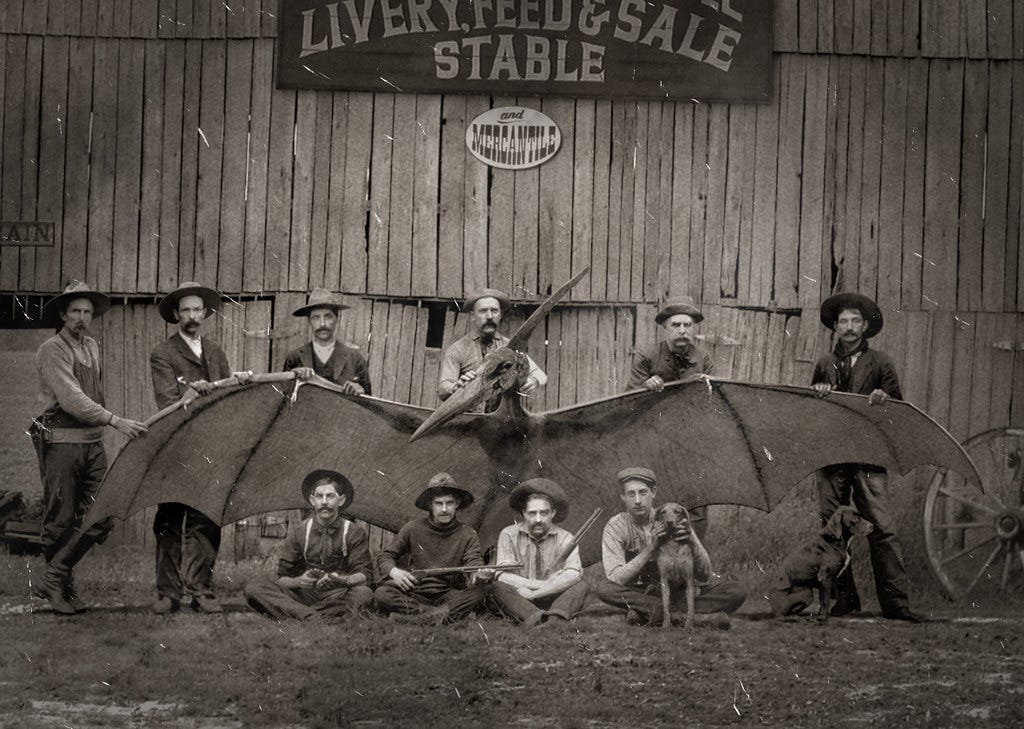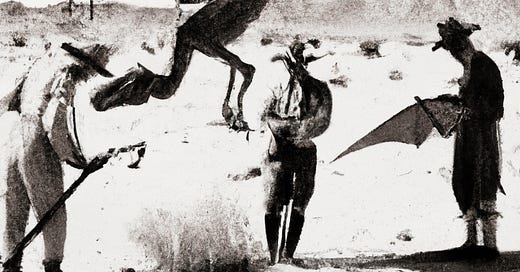In the spring of 1890, two ranchers were returning home on horseback across the southern Arizona desert when they encountered a very strange creature. It was, according to a report from the time, “a winged monster, resembling a huge alligator with an extremely elongated tail and immense pair of wings.” The creature was identified as a flying reptile thought to have been extinct since the Late Jurassic period about 150 million years ago—a living and breathing pterodactyl.
The encounter occurred on Sunday, 20 April 1890, in the remote desert between the Whetstone and Huachuca Mountains, a few miles north of the US-Mexico border and west of the San Pedro River. Today, the city of Sierra Vista sits in the valley between the mountain ranges. But in 1890, only four years after the end of the Apache wars, white settlers were only just arriving and setting up ranches and homesteads around Fort Huachuca, Arizona’s major army base. The nearest town, about 20 miles to the north east, was Tombstone, the famed setting of the 1881 Gunfight at the OK Corral. The strange creature encountered by the ranchers became known as the Tombstone Pterodactyl, or the “Tombstone Thunderbird”.1
According to a report in the Tombstone Epitaph on the following Saturday, the creature appeared to be exhausted and resting on the ground when the two ranchers approached. After the “first shock of wild amazement”, the ranchers pulled out their Winchester rifles and rushed at the creature. It immediately took to the sky, but, in its exhaustion, was only able to fly short distances before returning to the ground. The ranchers pursued the creature on its stop-start flight on an “exciting chase of several miles.”
Cowboys being cowboys, as soon as they got within rifle range, the ranchers opened fire and hit the creature. The wounded and exhausted animal turned on the men as they approached, but the ranchers were able to keep out of its way and fire a few more “well-directed shots”. According to the report, “the monster partly rolled over and remained motionless. The men cautiously approached, their horses snorting with terror, and found that the creature was dead.”
The ranchers proceeded to examine the creature and reported some startling measurements. According to the Epitaph, the creature's body was an infeasible 92 feet long. Its head was about 8 feet long, its eyes were “as large as dinner plates”, and its jaws were set with thick rows of sharp teeth. The men noted that the creature had two legs, like a bird, but was entirely featherless and hairless, and that its smooth skin had been easily penetrated by their bullets.
With some difficulty, the men extended one of the creature’s wings, which was covered in “a thick, almost transparent membrane”. The wing, they estimated, was 78 feet long, making the total tip-to-tip wingspan of the creature about 160 feet — the same as a modern Boeing 767 passenger jet. (That part of the story seems particularly implausible, as there is no evidence that pterosaurs, nor any other flying creature, had wingspans anywhere near that big.)
Unable to move the huge beast, they cut off the tip of one wing and took it home. A few days later, one of the ranchers rode into Tombstone to gather supplies and a posse of “several prominent men” to head out into the desert and retrieve the creature “before it is mutilated”. The plan was to skin the pterodactyl and send the hide back east for examination by “eminent scientists of the day”. The posse set off six days after the original encounter. There is no record of them returning with the creature. Or, perhaps, there is.
In subsequent decades, rumours surfaced of a photograph taken upon the creature’s return to Tombstone. Apparently, the men had nailed the creature to a barn and posed in front of it. Numerous witnesses recalled seeing the photograph, perhaps in the Tombstone Epitaph. However, that could not have been the case. A search of the newspaper’s archives shows the Epitaph did not publish photos in 1890.
The most commonly presented photo of the “Tombstone Thunderbird” is the one below, and it’s very definitely a deliberate fake, described by British digital artist Chris Smith on his Flickr page as “My version of the famous ‘lost’ thunderbird photo allegedly published in the ‘Tombstone Gazette’ in the late 19th Century.” Several other fake photos are in circulation, most of them much less convincing than Chris’s creation.2

In 1930, Major Horace Bell, a former US Ranger, retold the story of the Tombstone pterodactyl in his book, On the Old West Coast. A little after that, according to another story, an unnamed old cowboy approached a pressman in Tombstone and told him that he was one of the ranchers who had encountered the creature. The original newspaper story, he said, had been exaggerated, but it was partly true. The two men had shot at and chased the creature, but had not downed or killed it. Their horses had been spooked, and the men had been frightened, so they let it fly away.
Years later, in May 1963, writer Jack Pearl published an article in Saga magazine titled “Monster Bird That Carries Off Human Beings!” Pearl recounted several supposedly true tales of encounters with pterodactyl-like creatures, including one that he dated for 1886, but seems to refer to the story from 1890. According to Pearl, two prospectors brought a dead pterodactyl into Tombstone on a wagon, nailed the creature to a wall, and posed with it among a group of six men for a photograph. This seems to have been the earliest mention of a photograph, but it was not the last.
As revealed by authors Mark A Hall and Mark Lee Rollins in their book Thunderbirds: America’s Living Legends of Giant Birds, numerous people — naturalists, authors, and magazine correspondents—claimed to have seen this photo. But attempts to verify it failed. In 1966, the then-editor of the Tombstone Epitaph said he had searched the newspaper’s records and found no photograph, so—if it existed—it had no connection to the newspaper.
There was one further interesting anecdote. In 1969, Old West magazine retold the 1890 Tombstone pterodactyl story. A few months later, in 1970, a reader named Harry McClure wrote to the magazine to say he had met the two ranchers, and they had told him the story. According to McClure, the ranchers did encounter the huge creature in the desert, although its wingspan was *only* 30 feet, not 160. They did shoot at the creature, but it was out of range, and, as the story from the 1930s said, their frightened horses refused to give chase. So the creature got away, and the ranchers went to Tombstone with only a story, not a dead creature—nor even a wingtip. Nevertheless, a reporter at the Tombstone Epitaph published an embellished story—although not a photo, as no photo was ever taken.
So, could a pterodactyl or similar pterosaur have survived into the late 19th century in Arizona? We know that pterodactyls did once exist in Arizona. There are reports of miners and railroad workers finding fossilised evidence in the Victorian era. In 1957, the Journal of Paleontology reported the finding of pterodactyl tracks in the Arizona mountains. In addition, ancient cave paintings in neighbouring Utah are said to show a pterodactyl-like creature, suggesting that it might have avoided extinction and survived into the last millennium. (This theory has been debunked by scientists.)
It’s also worth noting that Dr John F Boynton, the palaeontologist and inventor (and founding member of the Latter Day Saints movement — although he later denounced Mormon founder Joseph Smith as a “fallen prophet”), toured US cities in 1869 with a popular lecture titled “The Age of Dragons”. Boynton introduced audiences to the megalosaurus, plesiosaurus, and the pterodactyl — which he had reconstructed using fossilised remains with an 18-foot wingspan. So the idea of a flying lizard was present in people’s minds.3
It seems highly unlikely the ranchers encountered a pterodactyl in Arizona in 1890, and if they did there is no photographic evidence. (The illustration at the top of this post is not, of course, a real photo.)4 But reported sightings of flying reptiles have continued through to the present day, particularly across the US western mountain states. Are there real pterodactyls in the American skies? I’ll leave you with this video and a website called Jurassic Kites…
Recommended: Shameless Christmas Plugs Edition
‘Tis the season to buy gifts for people, so it would be remiss of me not to mention that my brand new book, The Tyne Bridge: Icon of North-East England, might make a very nice present. It’s a handsome hardback with loads of photos telling the amazing story of a beloved bridge. “A gripping account of Tyneside’s own Arc de Triomphe,” says Dan Jackson (author of The Northumbrians). The Tyne Bridge is available from all good bookshops, and I also have a handful of signed copies available, which can be personalised as gifts. More details here: Tyne Bridge Book.
While I’m solving your Christmas gift conundrum, I should also mention my previous two books, both very much still available:
The Ruhleben Football Association: How Steve Bloomer's Footballers Survived a First World War Prison Camp is the incredible true story of how some of Britain’s most famous players used football to survive and escape a brutal WWI prison camp. “The real Escape to Victory,” said the Sports Journalists’ Association. The Ruhleben Football Association is available now from Amazon.
Savage Enthusiasm: A History of Football Fans is the complete history of watching football, from its earliest origins, via golden ages and troubled times, through to present day. “An impeccably sourced primer on what has happened to fans down the ages,” said When Saturday Comes magazine. Savage Enthusiasm is also available now from Amazon.
If you’re hankering for some Christmas content, here’s A Ghost Story of Christmas, from this time last year.
That’s all for 2022. See you in 2023. Be good and share or subscribe!
Thanks for reading this free newsletter. You can support Singular Discoveries by sharing it with friends. You can also browse my books or buy me a coffee / make a small one-off contribution. Click here. — Paul.
A pterodactyl is not a dinosaur but a pterosaur — a flying lizard. A thunderbird is a mythical winged beast thought by some native American tribes to cause the sound of thunderstorms with the flapping of its wings.
Kevin J Guhl has a comprehensive breakdown of these photos on his Thunderbird Photo blog.
Sir Arthur Conan Doyle reintroduced audiences to flying lizards in his 1912 novel The Lost World. In the novel, Professor Challenger claims to have discovered a hidden prehistoric plateau and produces as evidence part of a wing of a pterodactyl.
The image at the top of this post was created using AI bot Dall-E.










So amusing! I enjoy your stories so much.